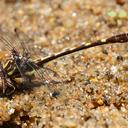United States and Canada
Common Sanddragon has a much wider range than Gray Sanddragon (P. borealis). It is slightly smaller with a complete midlateral thoracic stripe and a strong patch of brown basally in each wing. The thorax is pale yellow with a dark middorsal stripe widening anteriorly toward the collar and isolated from antehumeral stripe at its upper end. The humeral and antehumeral stripes are normally confluent at both ends with the thin pale stripe between them. The mid- and third lateral stripes are present and well-developed. The legs are short and darker than in Gray Sanddragon. The basal brown spot in each wing extends out generally to the first antenodal crossvein.
Size: Total length: 51-55 mm; abdomen: 39-43 mm; hindwing: 31-35 mm.
Similar Species (south-central US): Gray Sanddragon is larger and lacks two complete lateral thoracic stripes. Eastern Ringtail (Erpetogomphus designatus) is similar but the caudal appendages are both brown, not with yellow cerci and a black epiproct as in Common Sanddragon.
Habitat: Shallow streams and lakes with a sandy bottoms.
Natural History: This eastern species was erroneously reported from Presidio County. The record is actually attributed to Gray Sanddragon. Common Sanddragon is the most abundant clubtail species, found as larvae in many sandy-bottomed streams, of east Texas. Adults can be uncommon, taking refuge in wooded areas surrounding the streams they emerge from. It is not a particularly strong flier and is often seen obelisking. Females lay eggs by quickly flying low over the water and tapping their abdomens to the surface and occasionally while hovering over a riffle. This is the only North American clubtail where males guard females while they lay eggs. Males will remove sperm previously deposited by other males from females during mating, the first known instance in the family. In east Texas at least, one study found that chironomid larvae and mayfly naiads make up the primary diet of the immatures. I have found this species flying along side Gray Sanddragon as far west as southeastern New Mexico.
Distribution: Eastern U.S. and southern Great Plains.
Source: Abbott, J.C. 2006-2010. OdonataCentral: An online resource for the distribution and identification of Odonata. Available at OdonataCentral.
Edited by Drew Weber (9/24/2015).
